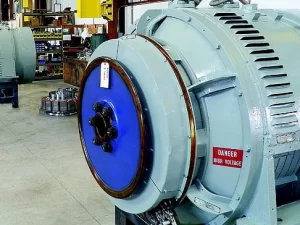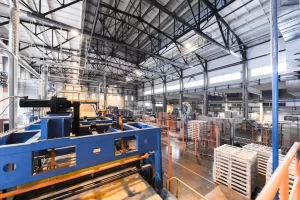PMSMs have strong industrial automation because high efficiency and reliability are associated with such motors. Quite a number of deployments, including robotic arms, conveyor belts, and CNC machines using PMSMs, deliver precise and constant torque and thereby preserve smooth and precise operation. In this regard, this means the PMSM is very efficient. As such, power consumption by PMSM depletes less energy. This is because it is one strong industrial point where everything remains continuous.
In general, those features of permanent magnet synchronous motors include high efficiency, high power density, good dynamic response, and low maintenance cost. Of course, it depends on permanent magnets. Its constant magnetic field interacts with the motor’s armature magnetic field to produce torque and rotation. Meanwhile, permanent magnets have a direct impact on the efficiency and stability of the motor.
High Efficiency
The high efficiency for which Permanent Magnet Synchronous Motors, or PMSMs, are known is due to the fact that in PMSMs there is no slip between the rotor and stator magnetic fields; hence, the PMSM reduces energy losses. High efficiency means lower cost of operation and lower consumption of energy, hence the eco-friendly features of PMSMs in many applications.
High Power Density
Another great benefit to PMSMs is that they have high power density. This means PMSMs can produce a considerable amount of power relative to their size and weight, a feature that is greatly applied in applications where space constraints are stringent. They can do this due to the presence of strong permanent magnets in conjunction with optimized motor design so as to make them generate high torques from compact form factors.
Good Dynamic Response
PMSMs have excellent dynamic performance, meaning they can respond very quickly to changes in load and speed; hence, very precise control over the operation of the motor is achievable. This becomes particularly important in applications that require exact control and rapid adjustments, for example, robotics, CNC machines, and electric vehicles. Besides, the fast response of PMSMs to control inputs makes them perfect for applications where high precision and agility are required.
Low Maintenance Costs
PMSMs are designed in such a way that the maintenance costs become less. There are no brushes and slip rings as in some other types of motors; hence, the wear on the components is less. The brushless design of these machines reduces frequent maintenance and replacements, hence reducing the long-term operating cost. Moreover, the rugged construction of PMSMs assures longer operating life and hence reduced costs.

The manufacturing process of permanent magnets is an important aspect in the performance of Permanent Magnet Synchronous Motors. Advanced processes are needed for the magnets to exhibit desirable magnetic characteristics: high coercivity, high magnetic energy product, and good temperature stability. These are very important characteristics to ensure efficiency, reliability, and life span for PMSMs.
With these, poor manufacturing practice will more than likely turn out low-quality performance in magnets, hence poor quality motors with higher energy usage and shortened operational life.
Of the many manufacturing processes existing to make permanent magnets, two are the most well-known; sintering and bonding; each with different advantages and applications, yielding very different characteristics and performance features in the magnets made accordingly.
Sintering Process
Overview and Process
Among the several producing methods, sintering has become one of the main ways to produce permanent magnetic materials of rare earth elements. In this process, first, the powder of rare earth permanent magnet compresses in a desired shape; afterward, it undergoes the heat treatment at temperature under its melting point in atmosphere control. Under the heat treatment condition, particles will be attached together and form one whole magnetic piece in a solid format.
1.Powder Preparation: The rare earth materials, like Neodymium, are milled into fine powders.
2.Compaction: Powder is compacted to the desired shape by a magnetic field that aligns particles.
3.Sintering: The powder compact is exposed to high temperatures, typically in an atmosphere generated between 1000° to 1200° of the material.
4.Cooling and Annealing: Sintered magnets are allowed to cool down to room temperature and annealing could take place to relieve internal stresses to improve magnetic properties
5.Machining and Coating: The sintered magnet undergoes proper machining to the exact dimension and sometimes coating is provided to protect from corrosion
Advantages
The advantages of sintering are given as
Bonding Process
Overview and Operation
This bonding process is otherwise called compression bonding. The powder of the permanent magnet, on mixing with the binder, develops a composite material. Then this material, on being pressed into shape, forms the desired one after being cured.
1.Mixing: Permanent magnet powder is mixed, with the aid of a binder like epoxy or rubber, into a homogeneous mixture.
2.Compaction: It fills the mould with mixture followed by compaction to obtain the desired shape and density.
3.Curing: The compacted mixture is then cured at often elevated temperature for binder to harden to form a solid magnet.
4.Finishing: Bonded magnets can also be treated with other finishing processes like machining and coating depending upon the requirement.
Advantages
The bonding process has its own advantages.
Simple Preparation: It is relatively a simple process and less complicated than sintering hence easy to adopt and apply.
Low Cost: The cost of production in bonding is relatively lower, involving simple equipment and processes.

Permanent Magnetic Field The most overwhelming reason why permanent magnets are significantly crucial in creating a constant magnetic field in PMSMs is that, unlike electromagnets, which must have an unbroken flow of electrical energy to keep their magnetic field working, permanent magnets produce a steady and unvarying magnetic field without any continuous input of energy.
In PMSMs, the permanent magnetic field is quite essential to the machine; it provides a stabilizing interaction with the magnetic field of the armature, hence leading to stable torque generation.
Interaction of Rotor and Stator Magnetic Fields
The base for the working principle of PMSM is the interaction of the magnetic field of the permanent magnet with the magnetic field of the motor-armature stator. When an electric current passes through the windings of the armature, a magnetic field results from it, interacting with the permanent magnets mounted on the rotor and creating an electromagnetic force-EMF-acting as torque to drive the motor.
The strength and proper alignment of the magnetic fields are very critical to the optimization of its performance; hence, the placement and quality of the permanent magnets will be a matter of concern. In other words, deep knowledge in permanent magnet technology is a pre-requisite for the development and optimization of PMSMs. This is how the state-of-the-art technology can spur the creation of such motors by engineers capable of meeting today’s demanding applications and opening ways for tomorrow’s innovation in industrial automation, transportation, and energy conversion. That is the future for PMSMs driven by innovative permanent magnet technology: higher performance, higher efficiency, and a wider application potential.